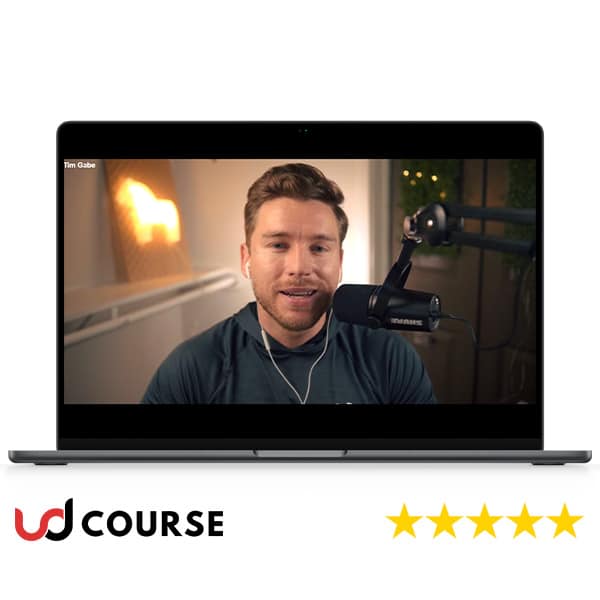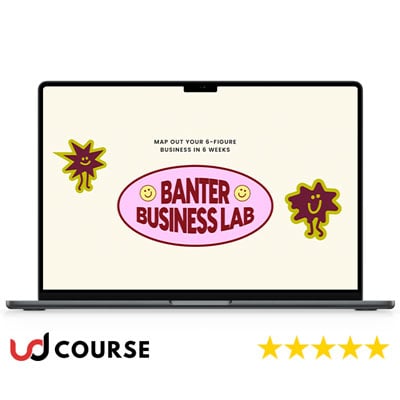
Christine Carrillo – The 20 Hour CEO
Christine Carrillo – The 20 Hour CEO: Redefining Leadership and Productivity
Christine Carrillo has revolutionized company leadership and productivity with her groundbreaking approach to managing her business. By limiting her workweek to just 20 hours, she has maintained and enhanced her organisation’s growth and success.
This strategy challenges traditional views of leadership and effectiveness, prompting a reevaluation of work-life balance principles.
Enroll in this course to unlock the secrets behind Carrillo’s success and transform your leadership style.
What Is the 20 Hour CEO Model?
Why Is This Course Worth Buying?
Christine Carrillo, a renowned business coach and successful CEO, has redefined what it means to lead effectively with her innovative 20-hour workweek strategy.
This course delves into the philosophies and practices that have allowed her to achieve exceptional business growth while maintaining a balanced personal life.
Carrillo’s model provides a fresh perspective on efficient leadership by focusing on strategic delegation, productivity, and time management. Whether you are an early-stage entrepreneur or an experienced executive, this course offers valuable insights to help you lead more effectively while increasing your quality of life.
How Did Christine Carrillo Develop the 20 Hour CEO Model?
What Are Christine Carrillo’s Career Milestones?
Christine Carrillo has achieved several significant accomplishments throughout her career that exemplify her innovative leadership and entrepreneurial spirit.
Initially embarking on her career in the competitive tech industry, Carrillo quickly demonstrated her prowess in strategic planning and execution. Her ability to identify unique market opportunities led to the development of groundbreaking products and services, establishing her as a forward-thinking leader in her field.
One of Carrillo’s notable achievements was the founding of a tech company that became renowned for its disruptive technologies and user-centric solutions. Under her leadership, the company flourished and redefined customer engagement strategies in its sector.
Carrillo’s dedication to fostering an inclusive and dynamic work environment propelled the company to heights, earning numerous awards for innovation and workplace culture.
How Did the 20-Hour Workweek Transform Carrillo’s Career?
Her decision to adopt a 20-hour workweek as CEO was pivotal in her career. This bold move was met with scepticism, yet it resulted in remarkable productivity and company growth, reinforcing Carrillo’s philosophy that work efficiency doesn’t necessarily correlate with longer hours at the office.
How Has Carrillo Contributed to Business and Community?
Beyond her business achievements, Christine Carrillo is a vocal advocate for work-life balance and reimagining the future of work. She leverages her platform to encourage other leaders to adopt more flexible and humane work practices.
Carrillo’s influence extends to her involvement in initiatives aimed at empowering women in technology. She mentors aspiring female entrepreneurs, promoting diversity and inclusion in the tech industry.
Carrillo’s contributions to the community include her work with non-profit organizations focused on education and skill development for underrepresented groups. Her efforts aim to bridge the gap in tech education, ensuring that everyone has the opportunity to participate in the digital economy.
What Is the Philosophy Behind The 20 Hour CEO?
How Does This Model Challenge the Hustle Culture?
Christine Carrillo’s revolutionary approach directly confronts the prevailing hustle culture. This culture promotes the idea that success comes from relentless work, often at the expense of personal well-being and life outside the office.
Carrillo advocates for efficiency and smart work over the traditional grind of long hours. By implementing a 20-hour workweek for herself and encouraging a culture of productivity rather than mere presence, she disputes the necessity of constant busyness. She addresses the inefficiencies within work norms that contribute to burnout and lower quality of life.
What Is the Connection Between Work-Life Balance and Productivity?
Delving deeper into Christine Carrillo’s philosophy reveals a nuanced understanding of the correlation between work-life balance and productivity. Conventional wisdom suggests a zero-sum game where increasing work hours results in greater productivity.
Yet, Carrillo’s experiences and the subsequent success of her tech company suggest otherwise. By structurally reducing her work hours to 20 a week, she has maintained and enhanced her company’s productivity and growth trajectory.
This paradigm shift underscores the importance of focused, strategic work and eliminating unnecessary tasks that don’t contribute to core business goals.
What Are the Key Takeaways from The 20 Hour CEO?
What Are the Time Management Strategies?
Christine Carrillo’s impactful approach to CEO leadership stands out prominently in her time management strategies. She capitalizes on prioritizing tasks that offer the greatest value, a technique necessitating discerning judgment and acute foresight.
Carrillo demonstrates how minimizing distractions and wisely allocating time can create a more productive work environment. By focusing on critical objectives and employing tools and methods to streamline operations, she supports her 20-hour workweek paradigm by batching similar tasks, setting clear objectives for each workday, and leveraging technology for efficiency.
How Does Empowering Leadership Work?
Embracing an empowering leadership style, Carrillo has debunked the myth that longer hours equate to better outcomes. Instead, she nurtures a culture where trust and autonomy are paramount.
By setting clear expectations and allowing her team to meet these objectives in their way, she cultivates a sense of ownership and responsibility among her staff.
This empowerment leads to higher engagement, creativity, and productivity, as individuals feel valued and capable of contributing their best work.
What Is the Value of Delegation?
A crucial element of Carrillo’s 20-hour workweek is the value placed on delegation. Recognizing that no one can excel at everything, she emphasizes the importance of entrusting tasks to others, particularly those better suited for specific roles or projects.
Delegation, in Carrillo’s model, is not just about offloading work; it’s about investing in her team’s growth and maximizing the organization’s overall effectiveness.
This practice allows her to concentrate on strategic planning and high-impact activities, ensuring that her limited time is spent on areas where she adds the most value.
How Can You Implement the 20 Hour CEO Model?
What Are Some Success Stories?
Many leaders report considerable success in adopting Carrillo’s model, highlighting several key benefits. Concentrating on tasks requiring their unique expertise maximises their impact within the organization.
Stories from various CEOs demonstrate how this method has led to more deliberate, thoughtful decision-making. They can allocate more time to strategic planning instead of getting bogged down by day-to-day tasks. This model promotes employee empowerment, as delegating operational responsibilities fosters innovation and ownership of projects.
What Are the Potential Pitfalls and How to Avoid Them?
Even though it has advantages, implementing the 20-Hour CEO Course model comes with its set of challenges. One common pitfall is the potential for miscommunication.
Given the reduced hours, it’s easy for messages to either not get relayed in time or to be misunderstood. To mitigate this, robust communication tools and strategies are crucial.
Another issue could arise from the delegation itself. Without proper training and trust-building, delegated tasks might not meet expectations, leading to frustration.
Investing in comprehensive training programs and fostering an environment that encourages questions and continuous improvement is essential.
What Is the Future of Work with the 20 Hour CEO Course Model?
How Does It Adapt to Changing Economic Realities?
Christine Carrillo’s 20 Hour CEO course model acknowledges and actively adapts to current economic challenges and opportunities. This approach allows leaders to efficiently allocate their time to high-impact activities while leveraging technology and team capabilities to handle day-to-day operations.
By working fewer hours, CEOs can dedicate time to analyzing trends, exploring new markets, and fostering innovation, which are crucial for long-term success.
How Does It Impact Corporate Culture?
Adopting the 20-hour CEO course model can profoundly affect a company’s culture. It introduces trust and autonomy rarely seen in traditional corporate environments, signaling a shift towards results-oriented management. This model encourages a culture of accountability, where employees are trusted to take ownership of their work, fostering a more engaged and motivated workforce.
It challenges the status quo of leadership, illustrating that effective management is not about clocking the most hours but about making those hours count.
Frequently Asked Questions
What Is the 20 Hour CEO course Model?
Christine Carrillo conceptualized the 20-hour CEO course model, emphasising strategic delegation, productivity, and an optimal work-life balance. It allows CEOs to work only 20 hours weekly while maintaining effectiveness through focused leadership and empowering teams.
How Does the 20 Hour CEO Model Benefit Companies?
Companies adopting the 20 Hour CEO course model see improved decision-making, higher employee satisfaction, and increased productivity. This model enhances work-life balance for leaders and fosters a more motivated and engaged workforce.
What Challenges Does the 20 Hour CEO Model Face?
The model’s main challenges include potential miscommunication and employee disengagement. Scepticism also arises regarding its feasibility and the risk of cultural disengagement within organizations that value traditional work norms.
Is the 20 Hour CEO Model Sustainable in Changing Economic Landscapes?
Yes, the 20 Hour CEO course model is seen as sustainable, especially as it aligns with the gig economy and remote work trends. Adapting to economic changes attracts talent that values flexibility, autonomy, and results over hours worked.
How Does the 20 Hour CEO Course Model Affect Corporate Culture?
The model promotes a culture of trust, autonomy, and accountability, challenging conventional leadership norms.
By emphasizing results over the number of hours worked, it aims to foster a dynamic and innovative workplace culture, potentially setting a new standard for leadership.
Join us in Christine Carrillo – The 20 Hour CEO course and learn how to lead your business with less effort while achieving more tremendous success. Unlock the secrets of efficient leadership and transform your work-life balance today!





